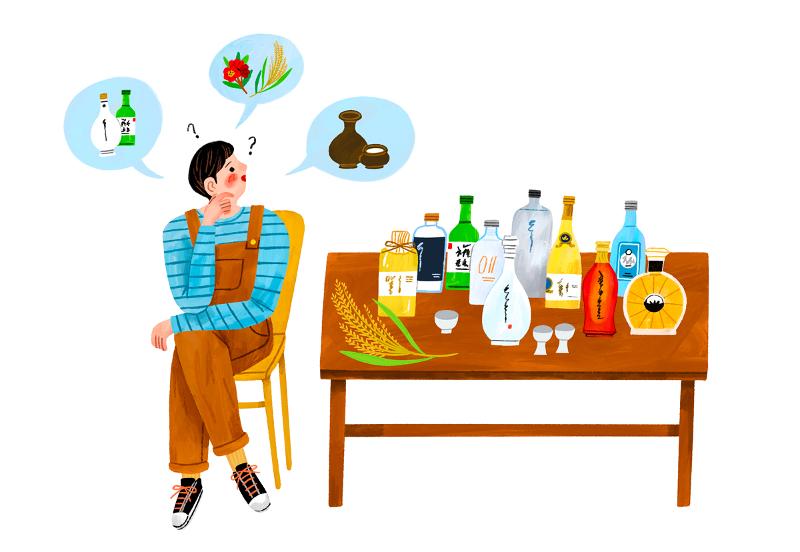
By Lee Ji Min
Director of traditional sool platform Daedongyeojudo
Traditional alcoholic beverages are taking off on the mainstream booze market in Korea. Made from a range of agricultural products from across the country, sool is winning popularity among customers through its multifaceted charms. Despite being described as traditional, such drinks are full of the new. From makgeolli (milky rice wine), yakju (clear liquor) and distilled liquors to wine, the country has many kinds of traditional booze.
Such drinks are also made in creative ways through experimentation with all kinds of ingredients such as rice, barley, wheat and sweet potato and even medicinal herbs and spices. The use of delicious fruits made in the country like grapes, strawberries, tangerines, kiwis and peaches have also opened a seemingly endless world of sool. This is a Q&A summary for non-Koreans who wish to learn more about traditional Korean drinks.

What is a traditional alcoholic beverage?
The dictionary defines traditional sool in Korea as an alcoholic drink made with traditional brewing methods. Due to its wide range, however, those made by people designated national, municipal or provincial intangible cultural heritage or culinary masters in the booze category or regional specialties all fall under the term. The important requirement is that these drinks are made of agricultural products produced, fermented and brewed in Korea
How many kinds of traditional liquor does Korea have?
It's hard to say how many kinds of traditional liquors are on sale. The nation has an estimated 800 breweries operating that produce numerous kinds of makgeolli. The value of the domestic market for traditional drinks rose 56% from an estimated KRW 40 billion in 2017 to KRW 62.7 billion in 2020.
Unlike the ubiquitous green bottles of soju or beer, what are the advantages of traditional booze?
I would say their use of quality agricultural products made in Korea. Traditional sool is basically made from rice, water and nuruk (fermentation starter) and a variety of sub-ingredients can diversify the taste. Add chrysanthemum to get chrysanthemum liquor, add azaleas to get dugyeonju (azalea liquor) or add pine tree shoots, lotus leaves or ginseng to make specialty drinks. Nowadays, an array of fruits or herbs is being used. Korea even has makgeolli made of shine muscat, tangerine, quince or mugwort widely beloved by customers.
What do you consider the biggest appeal of traditional sool?
Traditional drinks have endless charm, the biggest being an indefinite expansion of taste. Their flavor spectrum can vary depending on type of liquor, brewing method, main and sub-ingredients, fermentation and aging methods. The basic kinds of sool range from makgeolli, the most common liquor, yakju, soju and a distilled form of yakju to fruit-flavored varieties made of fermented and ripened fruit. A variety of crops, fruits, medicinal herbs and flowers are also used in brewing. As more concepts are added, they will expand the range of taste and appeal even further. I feel proud of traditional sool because most of its flavors are not found overseas.
What traditional drink earns favorable responses from people overseas?
Non-Koreans tend to show strong interest in new tastes and ingredients, unique flavors or acidity that they've never experienced before. For example, leegangju is known for its bittersweet taste made from pears, ginger, tumeric and cinnamon and omija (schisandra berry) wine allows drinkers to taste omi, or the five tastes of sweet, bitter, sour, salty and spicy. The taste of omija wine is so unique that one cannot find it overseas. This is why Omyrose wine of the brand Ominara has been often served at official banquets for state guests.
What traditional booze was the favorite of kings or historical figures?
I would pick gamhongno because it's the most mentioned in old records and literature. The best type is found in North Korea. This drink was one of the three specialties of Pyeongyang (the North's capital) along with naengmyeon (cold noodles) and goldongban (known in South Korea as bibimbap, or rice mixed with vegetables, meat and spicy red pepper paste). Gamhongno was the most popular drink of its time among alcohol lovers and gisaeng (female entertainers). Even in "Sugungga" (Song of the Underwater Palace), also known as "Byeoljubujeon" (The Hare's Liver) and one of the five pansori (solo lyrical opera) epics, the turtle tries to coax the rabbit into going underwater by saying, "We have gamhongno at Yonggung Palace (in the sea)."
Well-known historical figures also loved gamhongno, including Hwang Jini, considered the top gisaeng of the Joseon Dynasty (1392-1910). When she saw the renowned neo-Confucian scholar Seo Hwadam (aka Seo Gyeongdeok), she praised his manliness by comparing it to the drink's red color and strong taste.
Traditional booze also includes unique concoctions like yihwaju, a yogurt-type drink consumed with spoons. What other traditional sool has a unique taste or ingredients?
Yihwaju was the highest quality takju (cloudy alcoholic drinks) enjoyed by aristocrats of the Goryeo Dynasty (918-1392). The name is derived from yihwa (pear blossom) because it was brewed with nuruk at a time when pear blossoms bloom. Another name for it is baekseolhyang because the alcohol is colored white like snow with a good scent, and women especially like it. Many consider using spoons to consume it unique and it goes well with bread or crackers. This is also called anjeunbaengisul (sit-down drink) because it makes one drunk after one or two spoonfuls.
How should traditional sool of excellent fragrance and color be enjoyed?
Break the prejudice of insisting on drinking traditional drinks from a ceramic container to enjoy their taste more. Use glasses in a variety of forms at home. For makgeolli, enjoy it with fruit syrup as a cocktail and drink distilled soju with a high ball without worrying about its high alcohol volume. The side dish can be anything you want, even if it's not Korean.
How do Koreans recover from a hangover?
Koreans love curing a hangover by eating hot soup such as kongnamulguk (bean sprout soup), bokjiri (puffer fish stew) or hwangtaeguk (pollack soup). Some even go for spicy ramyeon (instant noodles) as they believe that the cool and refreshing flavor of the soup helps them discharge the alcohol consumed the day before. Many also use quick hangover cures easily found at convenience stores. If one mixes two types of alcoholic drinks, using a hangover helper is good but I consider just as effective drinking water as often as possible when drinking alcohol and a lot of warm tea or water the next day.
What breweries do you recommend visiting in Korea?
Many breweries are worth visiting across the country and I recommend the top 50 breweries designated by the Ministry of Agriculture, Food and Rural Affairs. Popular breweries among foreign drinkers are Sanmeoru Farm in Paju, Gyeonggi-do Province, for wild grape wines; Yesan Apple Winery in Yesan, Chungcheongnam-do Province, for apple wine; and Ominara in Mungyeong, Gyeongsangbuk-do Province, for omija wine. For breweries with a long history, try Sinpyeong Brewery in Dangjin, Chungcheongnam-do Province, or Yangchon Brewery in Nonsan in the same province.
What differentiates soju in a green bottle and its distilled versions?
Soju in green bottles is introduced as the world's bestselling cheap liquor but it's not distilled soju, it's diluted. To make it, cheap imported crops are used in fermentation, distilling it with over 95% of its alcohol (jujeong) made from a continuous distilling process, diluting it with water and adding sweeteners. Foreign visitors to Korea often say the scent of soju is similar to that of hand sanitizer and many say they find it hard to drink it more than twice. But distilled soju refers to liquor fermented with and distilled from crops. For example, it used to be called hwaju (fire liquor) because it was heated with fire, baekju (white liquor) due to its light and clean color, and noju as each drop is collected like dew. Distilled soju helps remove the aftertaste of greasy food thus goes great with popular Korean foods like samgyeopsal (grilled pork belly), galbi (ribs) and barbeque.
Where in Korea can people try a wide variety of traditional booze?
The number of places selling traditional booze in Korea has surged ranging from bottle shops specializing in traditional brews to wine shops, hypermarkets and convenience stores. Many bars and restaurants offer food and traditional sool. The Sool Gallery in Seoul's Bukchon Hanok Village (https://naver.me/5MUSLslR) offers a wide variety of such drinks and sampling of them. For those interested in making traditional sool, The Sool Company (www.thesoolcompany.com) is worth visiting in the Hyehwa-dong neighborhood of the city's Jongno-gu District.
Lee Ji Min is an expert in traditional Korean alcoholic beverages and since 2014 has run Daedongyeojudo, a promotional platform for traditional Korean sool. She has provided consulting to around 200 of the nation's breweries and judged traditional drink contests.
Illustrated by J.B. Han
Translated by Korea.net staff writer Yoon Sojung